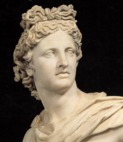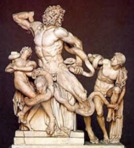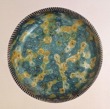

Making generalizations about the
visual culture of any group
of people is a crude endeavor, especially with a culture as diverse
as the Greeks'. With this thought in mind, know that this survey,
as any must be, is tremendously limited in its breadth and depth.
Examples:
![]()
Greece,
Cyclades, about 2500 BCE,
Male Harp Player, marble,
14.1 x 3.7 x 11 inches (35.8 x 9.5 x 28 cm), J. Paul Getty Museum,
Malibu, CA.

Mycenaean Greece, Helladic, Stirrup jar with octopus, c. 1200-1100
BCE,
Late Helladic IIIC, terra cotta,
height 10 1/4 inches (26.01
cm), Metropolitan Museum of Art, NY.
Greece, from Olympia, c. 750-700 BCE, Statuette of a Horse, Geometric Period, bronze, Michael C. Carlos Museum, Emery U, Atlanta, GA. Such bronze statuettes were most often dedicated in sanctuaries as votive offerings. A figurine much like this one appeared in the movie "Black Stallion," and was called Bucephalus.
![]()
Greek,
Crete, 690-670 BCE,
Lyre Player, bronze, height 4 1/2 inches (11.5 cm),
J. Paul Getty Museum, Malibu, CA.
![]()
Greece,
Figure of a Warrior, late 6th century
BCE,
bronze, Worcester
Art Museum, MA. See chiton.
Greek, Attic, Black-Figure Eye Cup with Ships, Archaic, c. 530 BCE, terra cotta, Michael C. Carlos Museum, Emery U, Atlanta, GA. This cup appears to act as a mask when the cup is raised to drink — the eyes staring out, the handles resembling ears, and the foot of the vase appearing as a mouth. The eyes serve an apotropaic function, driving away evil. See anthropomorphism, black-figure, ex voto, talisman, vessel, and votive.

Euphronios (Greek painter), Red-Figure Psykter with Feasting Hetaerae, 505-500 BCE, clay, height 34 cm, diameter of rim 14.2 cm, diameter of stand 14.5 cm, State Hermitage Museum, St. Petersburg, Russia.

Greece, Black-Figure Dinos with Ships, 510-500
BCE,
clay, height 17.3 cm, diameter of body 36 cm, State Hermitage Museum, St. Petersburg, Russia.

Greece,
Zeus
from Cape Artemision, c. 460 BCE,
bronze, National
Museum, Athens.
See a second point of view on this sculpture,
a third,
and a second detail of the head.

Greece, Grave stele of a little girl with doves, c. 450-440 BCE, Parian marble relief, height 31 1/2 inches (80 cm), Metropolitan Museum of Art, NY.

Dexamenos (Greek, Chios), Intaglio of a Flying Heron, 5th century
BCE,
chalcedony, gold,
1.7 x 2.2 cm, State Hermitage Museum, St. Petersburg, Russia.

Discus Thrower (Discobolus), Roman copy
of an original bronze
by Myron
 (Hellenistic
Greek, c. 485 - c. 425 BCE),
marble.
(Hellenistic
Greek, c. 485 - c. 425 BCE),
marble.
A second point of view of
the Discus Thrower. See
point of view.

Greece, Temple Pendant with the Head of Athena Parthenos,
first half of the 4th century BCE,
gold, enamel, State Hermitage Museum, St. Petersburg,
Russia.
![]()


Greek, Apollo Belvedere, c. 330 BCE,
marble, Vatican Museum.
Detail: the head of the Apollo
Belvedere. See fig
leaf.

Apoxyomenos
(Scraper), Roman
copy of an original
bronze by Lysippos, a Greek sculptor who worked c. 325
BCE,
marble, height
82 inches, Vatican. Apoxyomenos, a gymnast, is portrayed
scraping dusty oil from his right arm with a tool called a strigil.
Lysippos provided the foundation for Hellenistic sculpture.
The sculpture's fig leaf
was added later as censorship
in the interest of modesty.
![]()
Greece,
Apulia, South Italy, attributed to the Painter of Louvre MNB
1148, about 330 BCE,
Red-Figure Loutrophoros (Type I) with Ovoid Body,
terra cotta, height
35 1/2 inches, diameter (rim) 10 1/2 inches (h. 90.1 cm, d. 26.0
cm), J. Paul Getty Museum, Malibu, CA. See red-figure.

Greece,
Figurine of Aphrodite Playing with Eros,
tanagra, late 4th century
BCE,
terra cotta, height
18.5 cm, State Hermitage Museum, St. Petersburg, Russia.
![]()
Greek,
late fourth century BCE,
Statue of a Victorious Youth, bronze with copper
inlays, height
59 5/8 inches (151.5 cm), J. Paul Getty Museum, Malibu, CA.
![]()
Greek,
Alexandria, Egypt, 220 BC - 100 BCE,
Hairnet, gold,
garnet, and glass paste, 8 1/2 x 3 1/8 x 3 inches (21.5 x 8 x
7.5 cm), J. Paul Getty Museum, Malibu, CA. See jewelry.

Laocoön and his Sons, Roman copy of a Hellenistic
original from c. 200 BCE,
marble, height
1.84 m, Vatican. Trojan priest Laocoön and his two sons
are attacked at an altar
by giant snakes. Pliny
said it was the work of three sculptors
from Rhodes, Hagesandros, Polydoros, and Athenodoros. The date
of the Laocoön is controversial, some scholars arguing for
the late second century BCE,
others for c. 50 BCE.
See pain.

Sleeping
Satyr (Barberini Faun), Roman copy after a Hellenistic
original of c. 200 BCE,
Glyptothek, Munich. With various parts of this sculpture missing,
in the state in which it was found, a number of repairs have
been made. The right leg is one such modern addition. Not seen
here, but visible in other modern photographs are reconstructions
of the left forearm and foot.
Hellenistic Greece, Samothrace (island in the North Aegean Sea), c. 190 BCE, Nike on the Prow of a Ship, called the "Winged Victory of Samothrace", gray Lartos marble for the ship's prow, white Paros marble for the statue, height 3.28 m (floor to top of wings) (10 feet 9 inches), Louvre. See Hellenistic and Nike.
Hellenistic Greece, Melos (the Cyclades islands), Aphrodite, known as Venus of Milo, c. 100 BCE, marble, height 6 feet 10 inches (2 m), Louvre. Signed on the base: "[Alex?]andros son of Menides from Antioch-on-the-Meander made it".

Greece, Shallow bowl, Late Hellenistic, 1st century
BCE,
fused mosaic
glass, height
3.43 cm, diameter 13 cm,
George Ortiz collection.
![]() The flag of modern Greece.
The flag of modern Greece.
Also see anastole,
ancient, Apollo,
archaeology, chiton,
colossus and colossal, fibula,
flags of Europe, frieze,
Golden Mean, muses, mythology,
neoclassicism, Nike,
numismatics, Renaissance,
Roman art,
UNESCO Convention on the Means
of Prohibiting and Preventing the Illicit Import, Export and Transfer
of Ownership of Cultural Property, and UNIDROIT
Convention on Stolen or Illegally Exported Cultural Objects.
https://inform.quest/_art